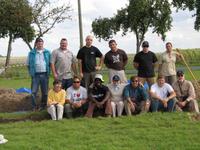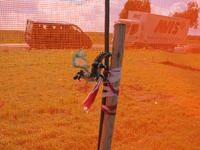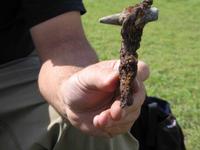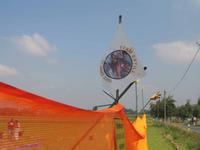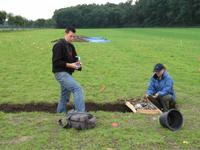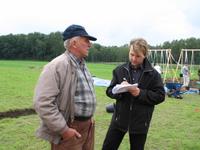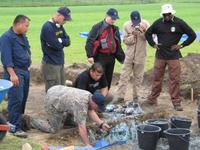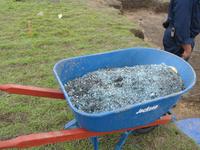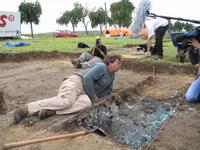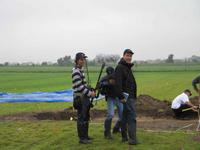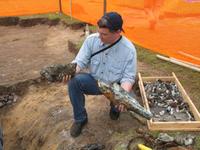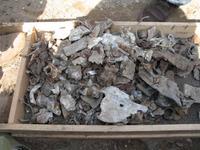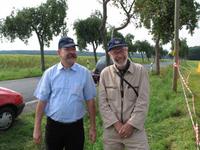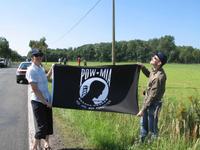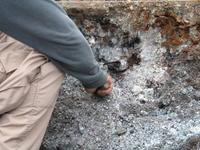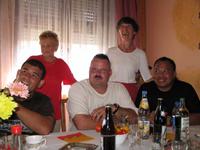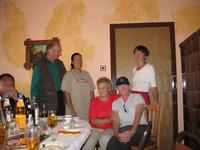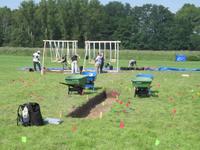As usual, Ernst took me to the field around 9 a.m. for one last look at the crater that contained so much, but in the end, offered only a small measure of its worth. As I stood there for the last time, I wanted to fly above it and see it as I knew it must look from above - just like a P-38. My father's fighter group uses such an image on their newsletter. It is indelible for me now in its symbolic and concrete message. If you knew it was a P-38 that had an unfortunate landing here, you could be shown the lines in the dirt below the surface of the working field. Simply amazing.
There I was, feeling at "sixes and sevens" and somewhat startled at this sudden-after-60-years ending of this quest, WHEN, Hans-Guenther, God of Airplane Parts, invited me to accompany him to Dresden and Meissen. Meissen has, among other things, the oldest pottery manufacturing plant in Germany. I had, in fact, discovered a shard of pottery stamped with the crossed swords mark of Meissen in one of the screens. I agreed to go because I enjoy HG's company, we are seasoned traveling companions, and it seemed like a great way to avoid certain malaise. I realized, too, that a good many questions remained unanswered and a day trip with this particular expert was fortuitous, indeed.
As Dr. Fox and I held our last meeting at the crater's edge late Monday afternoon, he told me about another possible place in the field, along the boundary fence, wherein it was rumored that airplane parts and possibly remains had been buried two weeks after the crash. He considered it possible, he said, but improbable. A decision was made not to explore that area because enough had been gathered from the existing site to prove, beyond a doubt, that this was the place where my father's plane crashed the afternoon of Friday, April 13, 1945. The amount of material taken from the site is estimated at one-half ton give or take a few kilograms.
This is where my day with HG gets interesting. Inspired by the final moments of seeing the crater as no one would ever see it again (but for future archeologists who will unearth it differently, if at all), we left for our overland excursion. We began with the question, "What went away from the plane as it crashed?" HG's reply was that the plane was probably spinning toward the earth. Spinning can be, as one might imagine, described in infinite ways. As it applies in this case, it was at an unknown speed at a steep or flat angle. The plane was most likely hit by anti-aircraft fire just over where the crash occured. It looks to the trained eye (not mine) like the speed of the spin determined the shallow depth of the crater. Most of the damage happened at the point of impact and as a result of the subsequent fire due to stored ammunition and fuel supply.
The sheared off front landing gear was found between the engine and cockpit craters and was not moved after the crash. This MAY mean that the airplane landed right side up. If it were the other way, the front wheel landing gear would have been on top and probably salvaged for its valuable steel.
The question of what fell away from the plane remains a mystery. HG believes that there is possibly another 6 x 4 meter hole containing these items along with another hole said to be located at the other end of the field near the adjacent road. This was where one of the engines was supposedly found but the crater we excavated shows evidence of both engines landing there. A part of one or both engines which measured 1.5 meters would have protruded from the ground. This calculation is based on the depth of the crater and the known circumference of the engines. Those parts were taken away by the farmer so he could continue his plowing.
Both ailerons were found in the crater plus the counterbalance weights that were attached to the wing tips. No main landing gear was found which logically should have been present along with the rest of the plane, nor were the superchargers, and most of the cockpit along with what it contained.
The above mentioned 4 x 6 hole may have served as a field grave which would have included anything that didn't bury itself in the crash or was deemed valuable. If this field grave exists, no remaining eye-witness to the event has come forward.
HG believes that nothing was thrown back into the main crater after the crater was filled with whatever was found there and has been left undisturbed, except for occasional relic hunters, over the past 60 years. One variation on this theme is that both machine guns from the plane were dug up in the late 1940's and handed over to unknown American officials. He assured me that speculation and rumor always swirls around crash sites and that facts are only determined through excavation. He feels that a full and complete job was done in the found crater. He also said he would bring his best deep penetration detector to the scene "just for a look."
There may be more than 100 P-38 crash sites still left to be found in Germany. Only a few are associated with MIA pilots. Many of the pilots bailed out and were either rescued or forever lost but are no longer with their plane.
You may notice the number of times I use the words "possible" and "may be" in this brief report of loss. That is because everyone is involved in the practice of highly educated deduction along with intuitive guessing, in conjunction with sorting and filing of accounts that may POSSIBLY be skewed after six decades of recollection and telling. The crater evidence is irrefutable.
My feelings are this (sínce every reporter in Germany seems to ask):
If my father's crash site alowed people of this area to forage for metals and materials (including my father's possessions), he would have wanted something useful to come of this catastrophe. He would have encouraged them to take what they needed to sustain themselves in their country that was without economy at the end of the war. I like to think that the pieces of the aircraft were recycled and made valuable again in some way we cannot imagine. Even if his watch and ring were taken by someone who found them irresistable, my father would want that.
I didn't know my father from seeing his face, by touching his hand, looking into his eyes, or hearing him laugh, but I know from the letters, from his constant presence in my life, through my children - his grandchildren and great grandchildren, his parents, his sister and brother and their children, through my mother. He would have handed out every part of himself and his plane in order to ease the suffering of others and to do the next right thing. That's the truth of it.
Am I sad because it is over? If it is as HG suspects, a possible second or third site may remain but the major work is done. The inventory of found parts accounts for my father. If there is more, it doesn't discount the inherent value of what the JPAC team brought up for me and for my father. A few parts that miraculously appeared in the dirt (the exact color of the dirt making the parts even more miraculous), will accompany him on his trip home. They are: a single green folded over button, a swatch of parachute silk, a tiny section of parachute line, a few boot eyelets with a lace piece still attached to one, and a few things yet to be determined. Am I satisfied? Yes. Does this change anything for me? It inspires me to fully consider things and people as even more fascinating and complex. My father's field taught me that what we see on the surface is nothing compared to what lies beneath. And then, it is up to us to determine how what you find is valued. I value every tiny fragment of this grand challenge and I have a precious little folded green button and a handful of boot eyelets and parachute silk to prove it.
From here, I fly to Frankfurt and on to Cologne to Ernst and his wife, Helga's, home in the Eifel Mountains. Our plan is to visit the American Cemetery in Margraten, Holland where my father's name is engraved on the Wall of the Missing. I will begin the process of placing a gold star added in front of his inscription, indicating that he has been found. Then we will go to Belgium to search again for the former site of the chateau where my father's squadron lived. HG and I attempted to find it a few years ago but we only found the Abbey where my father attended Mass.
My father's remains and anything considered personal effects, will be taken to Landstuhl, Germany for certification and examination and then to Hawaii. Once the Central Identification Lab conducts the necessary tests and writes the reports, I will be notified. My hope is to go to Hawaii and escort my father home myself. In the interim I will be making arrangements with Arlington National Cemetery for a full military funeral complete with a missing man formation fly-by. You know by now that I believe in possibility. Just takes good planning.
I will have access to room service and in-room Internet connection by Friday! I am hopful about having picture uploading under my own control once again. Also, more may be revealed. It's only been sixty years..........



